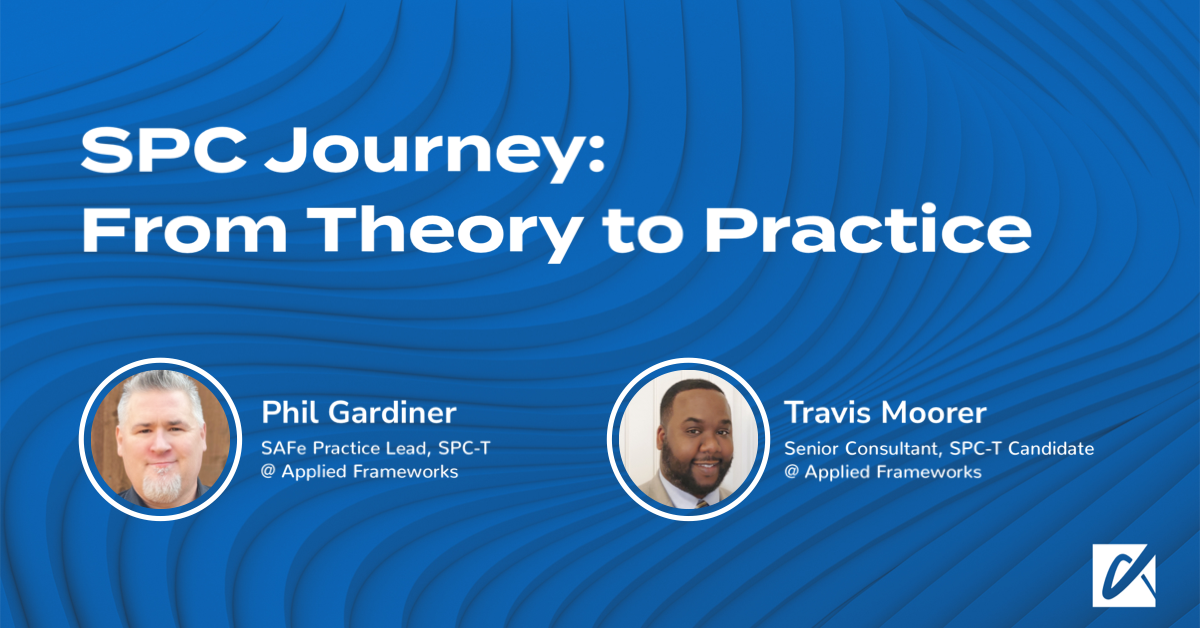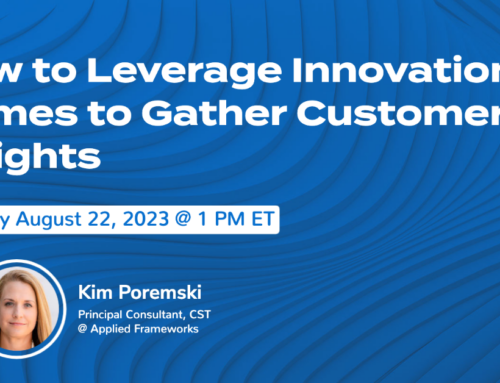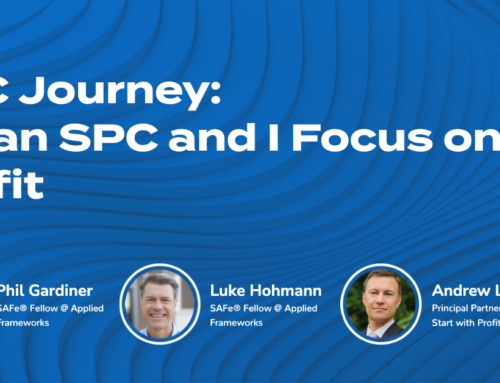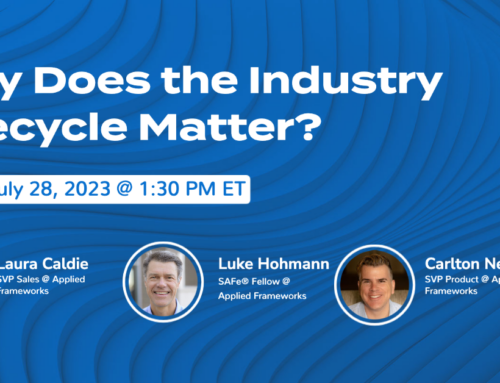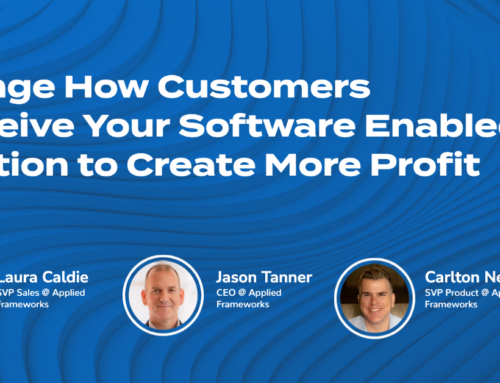SPC Journey: From Theory to Practice! Miss the session? Watch the Recording!
A critical point in the SPC Journey is when you put your knowledge into practice for the first time – there can be some exciting, challenging, and enlightening moments. Join SPCT Phil Gardiner and SPCT Candidate Travis Moorer as they discuss some of the “ah-ha” and “uh-oh” moments one might encounter when implementing SAFe® as a new SPC or change agent.
“Some things are taught, and some things are caught.”
Together, we will explore topics including:
- PI Planning: beyond the simulation
- The ART Readiness checklist is more than a checklist
- Alignment as a leading indicator
- Features are not requirements
- WSJF is collaborative
Interested in learning more? Please contact us to learn more about how our consultants can help your organization or Schedule a meeting with our Client Delivery Team.
Questions & Answers
How have you, in your journey, balanced between watching the movie in multiple organizations and helping others enjoy it and discover things themselves as they move along their agile journey?
Phil: Some additional thoughts… This balance has changed over the years. During my first SAFe implementation, I was the evangelist and architect driving it all. I wanted followers to believe in my mission as I thought I was the expert and needed to decide everything. In the next leg of the journey, I was humbled and learned the power of professional coaching and the sustainability that comes with someone coming to their own conclusions. For the last several years, I have found balance through a focus on the customer’s outcomes and some blunt conversations regarding the role I will play in their implementation. Sometimes, they want a consultant to co-create a plan that will eliminate or circumvent many of the growing pains they would naturally encounter. Other customers seek a mentor to help them learn through partnering. In any engagement, I believe that the approach has to ultimately result in the customer being able to sustain and evolve the new way of working without reliance on me or others outside their organization who serve them as consultants, coaches, mentors, etc.
Lining up execs and managers for a 2-day Leading SAFe or LPM course is tough because it’s a “big-batch”. It also leads to delayed feedback because it can take months/years to apply most of what they learned during the training. Has anyone tried providing SAFe training in “small-batches”, one lesson at a time & allowing for putting the theory into practice before moving on to other lessons? Was the outcome better?
Phil: Yes. I have experimented with a cohort model, with lessons over several weeks. It was not a model I recommend as a practice to adopt across the board as too many logistical challenges can disrupt the class flow. I have found that the insights a participant gains in class are valuable and encourage people to leverage them. SAFe courses have an “actions” section in each lesson. Rather than keep this private, I encourage them to write them in SAFe Collaborate or another concurrent collaboration tool to make them visible and create shared accountability. Additionally, when I teach privately, I prefer to schedule time after class to help participants connect what they learned and their insights to develop a plan of action.
Travis: Regarding Executives and Leading SAFe, here is some food for thought. SPCs have access to an Executive Workshop Toolkit that provides resources to prime the pump and get leaders excited about the benefits of a digital transformation. I recommend you group your participants in a way that allows psychological safety. Managers may not feel free to speak about specific issues in front of execs or vice versa. We want to ensure that the executive leaders are versed enough to understand SAFe terminology and provide support when needed. Remember, leadership is the foundation of a successful agile transformation. Providing SAFe training in small batches can be successful when consistent. Too much time between learning can be detrimental to success. Consistent messaging from one or two instructors ensures that everyone hears and implements the same message. Is the outcome better? I hate to say it, but that all depends on the culture and the individuals willing to try “small-batches” as a solution.
The community I work in is in a similar boat, so we have talked about coming up with a fake product and then simulating a PI planning session. Our thought was two 1-hour sessions to simulate each Day of the PI planning agenda. Would it be possible to get someone at Applied Frameworks to facilitate such a simulation?
Phil: In September 2022, I worked with a team of volunteer SPCs to facilitate a virtual PI Planning event for the Scaled Agile DFW meetup. I’d be happy to share some of the insights from that event with you as well as see if the volunteers would be interested in doing it again.
As a new SPC, supporting an ART; what kind of metrics would you recommend to present to upper management. If you can share examples, visuals would be nice.
Phil: We touched on this live; however, I wanted to provide the link to the SAFe Metrics article that I referenced. Check out the three metrics domains and I think you will find some examples in there. Ideally, there would be one or more metric that provided actionable insights for outcomes, flow, and competency.
What are major benefits one can observe by using SAFe?
Travis: There are many benefits of using SAFe. One of the biggest for me is PI Planning. This is a trademark event in the framework, that allows us to spend two days optimizing the next 10-12 weeks of work. I love this event because it cuts down on the delay of getting a problem solved. Everyone you need is in attendance so magical things that would take weeks or months to fix are handled in real time. This leads to many other benefits such as camaraderie, trust, and a sense of empowerment that my voice is heard and valuable.
Phil: I personally have seen both enterprises and Federal Government programs achieve some of the results listed on SAFe’s “about” page. The one that I see most often is a reduction in lead time to get a high quality product or service into the customer’s hands. Additionally, those customers who reach the point where “this is just how we work” and have leaders who regularly demonstrate behaviors based on lean-agile values and principles, you end up with a generative culture of inspired and engaged people.
What are some of the out of the book lessons learned in running participatory budgets, recently running this event in an old organization went rather smoothly, but then post event the finance team reverted back to ways of old, how do you make this stick?
Travis: Making it stick is the tricky part. Trends are showing that early implementation is helpful to making LPM stick. Finding a Consultant/Coach with experience increases the rate of success. Participatory budgeting is great as we use that exercise to understand our investment horizons and how they align with the Strategic Themes of the enterprise. Coupled with market research and data we can make the best decisions to optimize the portfolio. Small wins are the best way to tell the story of the LPM journey and help transform the culture and mindset of those responsible for maintaining the financial health of the enterprise.
What would you do as an RTE if stakeholders ask you to add two or three teams in the middle of PI execution?
Travis: This question was answered Live during the session (watch the recording!) however, I wanted to add a little more here for context. Figuring out the why is important. What do we gain or lose by making this decision. This will help us to understand whether or not the extra effort is worth the investment. Understanding the cost not just dollars but man power is critical. I want to note that sometimes the client is not going to take your advice. Remember it is their engagement and we do our best to help them along the journey even when we don’t agree with their choices. Look at it as an opportunity to gain trust and strengthen your relationship by moving at the speed comfortable for the client.

